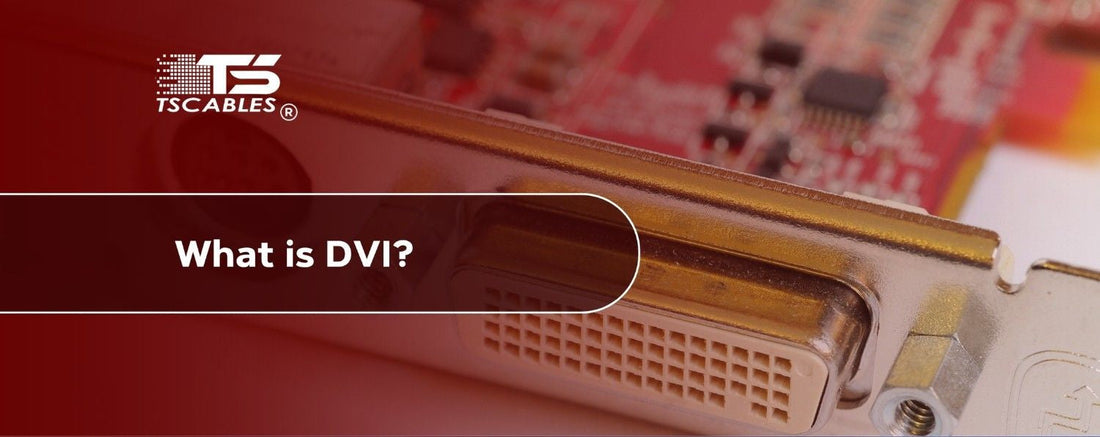Some cables confuse people, and DVI is one of those. It’s been around for a while and still shows up in monitors, desktops, and projectors. It looks wide, has pins, and gets mistaken for VGA or HDMI. But it’s different. This article explains what a DVI cable is, how it works, and why it still matters.
We’ll keep it simple. You’ll know what it does, where to find it, and how to tell it apart from other cables. DVI may seem old, but it still holds value in many places, especially where HDMI isn’t an option.
What is DVI?
DVI stands for Digital Visual Interface. It was created to send video from a computer to a screen. It does not carry sound. That’s a key difference from HDMI as DVI is mainly used for monitors, desktop PCs, and older projectors.
So, what's a DVI port? It’s a long, rectangular connection with multiple pins. You’ll often find it next to HDMI or VGA ports on a DVI pc setup. DVI can handle both digital and analog signals, depending on the cable type. This gives it some flexibility in older and mixed-device setups.
People often ask, Is DVI analog or digital? The answer is that it can be either. That depends on the type of DVI you’re using. We’ll cover those types next.
Types of DVI Connections
DVI isn’t just one thing. There are several types, and each works a bit differently. You’ll need the right one to match your gear. Get this part wrong, and you’ll get no video or a fuzzy screen. There are three main types: DVI-D, DVI-A, and DVI-I. Each has its own use case.
DVI-D (Digital Only)
DVI-D carries only digital signals. This version is best for flat-panel displays and LCD monitors. It connects well with HDMI using a simple adapter. It’s clean, reliable, and more common in newer setups.
DVI-A (Analog Only)
DVI-A is for analog signals. It works like VGA and is not used much anymore, but still shows up on some older graphics cards and screens.
DVI-I (Integrated)
DVI-I can handle both analog and digital. That makes it more flexible. You can use it with either VGA-style displays or newer digital ones. You’ll still need the right adapter or cable to switch signal types.
Single-Link vs. Dual-Link
DVI also comes in two link versions. Single-link supports lower resolutions. On the other hand, dual-link supports higher resolutions and refresh rates. If your monitor flickers or cuts off, you might be using the wrong link type.
What is a DVI Port Used For?
The connection DVI provides is stable and trusted in many setups. It may not carry sound, but it does a fine job with visuals. You’ll still see it in business setups, older monitors, and mid-range graphics cards. Here are the most common places and reasons people use DVI today.
Connecting Desktop PCs to Monitors
Many computers still use DVI on computer to connect to displays. It handles resolutions like 1080p without issues and is easy to set up.
Graphics Cards and Gaming PCs
Older graphics cards often include a DVI output port. It’s useful for dual-monitor setups or systems without HDMI. Some gamers stick with DVI for lower input lag.
Projectors and Presentation Gear
Projectors with a DVI input are still common in classrooms and meeting rooms. DVI provides a clear image and avoids the handshake issues some HDMI devices face.
Adapters for HDMI or VGA
If your screen has only HDMI or VGA, you can still connect a DVI port with the right adapter. Knowing DVI-D or VGA is better helps you make a smart choice. DVI-D usually offers better clarity and signal stability than VGA.
Video Testing and Repairs
Techs use DVI to test displays during repairs. It offers a stable signal that helps isolate hardware issues. Therefore, it becomes an optimal choice for video testing and repairs.
How DVI Stacks Up Today
DVI isn’t new tech. But it still has a place. It won’t carry audio. It doesn’t support 4K. Still, it works well for everyday use where simple video output is all that’s needed. DVI does its job with no fuss.
Some ask, what is a DVI port used for in modern settings? Mostly for connecting desktop monitors and projectors. It’s often found as a backup port or part of older multi-display setups. While HDMI has become the new favorite, DVI is still reliable and cost-effective.
One thing to note here is that you don’t expect DVI to handle smart features. It’s built for video only. If you’re looking for something with audio, or one cable that handles both, HDMI or DisplayPort are better bets.
Still, in environments like schools, small offices, or even repair shops, DVI keeps systems working without headaches. And that matters.
Wrapping Up
DVI has held its ground for a long time. It may not be flashy or new, but it still works where it's needed. It connects clean video, supports older monitors, and doesn’t get in the way. Whether your system uses DVI input or DVI output, knowing what DVI is and isn’t helps you get the best from your hardware.
TS Cables carries dependable DVI cables and adapters built for clear video signals and stable connections. Browse their collection to find exactly what fits your setup.
FAQs
Does DVI carry audio signals?
No. DVI supports video only. You’ll need a separate cable for sound.
What’s better: DVI-D or VGA?
DVI-D usually gives sharper, cleaner video than VGA, since it's digital.
Can DVI connect to HDMI?
Yes. With a proper adapter, DVI-D connects to HDMI for video.
What’s a DVI cable used for today?
Mostly for monitors, projectors, and older PCs where HDMI isn’t available.
Is DVI still used in new computers?
Some desktops and graphics cards still include DVI ports, but they are less common than before.






